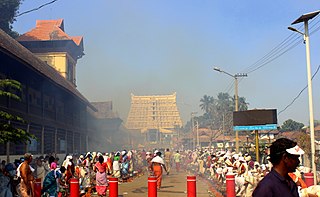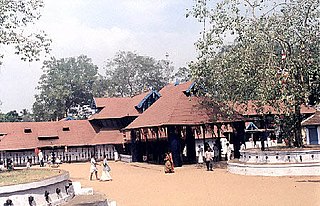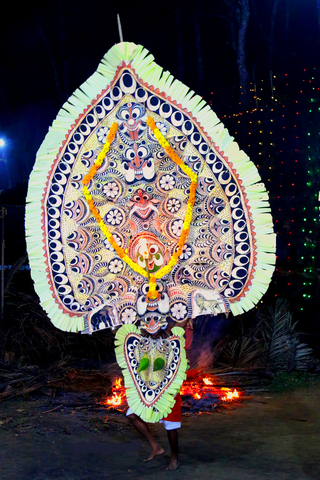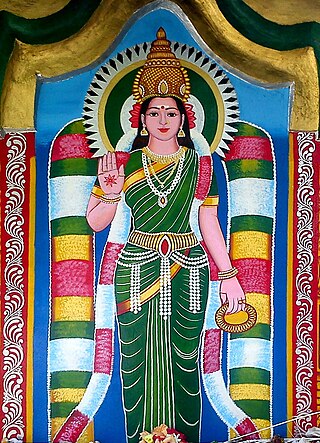
The Chottanikkara Devi Temple is a temple dedicated to the Hindu mother goddess Bhagavati.She is believed to be residing in Chottanikkara (Mahalakshmi) along with her Husband Maha Vishnu. The main deity is also considered as Lakshmi Narayana according to the temple legend. The temple is Classified one among the 108 Abhimana Kshethram of Vaishnavate tradition. The temple is located at Chottanikkara, a southern suburb of the city of Kochi in Ernakulam district, in the state of Kerala, India and is one of the most popular temples in the state. The temple is also known for conducting exorcism.

Bhadrakali, is a Hindu goddess She is considered to be the auspicious and fortunate form of Adi Shakti who protects the good, known as bhadra.

Garudan Thookkam is a ritual art form performed in certain Kali temples in some Central Kerala districts in south India. The people who dress up as Garuda perform the dance. After the dance performance, the hang-designate dangle from a shaft hooking the skin on his back. In some places, the ritual is performed colorfully with Garudas taken in a procession on bullock carts or boats or hand pulled carts. It will be available in Devi temple during the festival of Meena bharani and Pathamudayam in Thiruvanchoor in Kottayam district.

Attukal is a Hindu pilgrimage centre located on the banks of Killi river, in the capital city of Thiruvananthapuram, Kerala, India. It is situated about two kilometres to the south east from Sree Padmanabhaswamy Temple.

The Kodikkunnu Bhagavathy Temple or Kodikkunnu Ambalam is a Hindu temple dedicated to the goddess Durga located in the village of Pallippuram, near Pattambi, in Palakkad district of Kerala, India.

Sarkaradevi Temple is one of the most important temples in South India. It is situated Chirayinkeezhu town in Thiruvananthapuram district.Tradition accords a remote antiquity to this temple. Its main deity is Bhadrakali. The Sarkaradevi Temple assumed a significant status for many reasons and rose to historical importance mainly with the introduction of the famous Kaliyoot festival by Anizham Thirunal Marthanda Varma, the Travancore sovereign, in 1748. The Sarkaradevi Temple have some basic attachment with Nakramcode Devi Temple which located in Avanavanchery, Attingal.

Chettikulangara Sree Bhagavathi temple is one of the most renowned Hindu temples in Kerala. Main deity Sree Bhadrakali, The temple is located at Chettikulangara in Mavelikkara taluk of Alappuzha district in the Indian state of Kerala. The temple is situated about 4 kilometres (2.5 mi) west of Mavelikkara town, 7 kilometres (4.3 mi) north of Kayamkulam city on SH6. Bhadrakali, is an incarnation of supreme mother Shakthi devi, born from the third eye of Lord Shiva, to kill the demon king Daruka. 'Bhadra' means good and 'Kali' means goddess of time. So Bhadrakali is worshipped for prosperity and salvation. Devi is considered as the creator, protector, destructor, nature, power and Kundalini shakthi. Chettikulangara is located near Kayamkulam city.
Pazhayannur is a town and panchayath in Thrissur district, in the state of Kerala, India. The eminent mridangist, Palghat Mani Iyer was born here.

Sree Bhuvaneswary Temple, Valamchuzy is one of the oldest temples in Pathanamthitta, South India.
Theeyaattam also known as Theeyaattu (Tīyāttu) is a traditional temple dance form of Kerala.

The Mullakkal Rajarajeswari Temple is a Hindu temple in Alappuzha, Kerala, India. The temple is also known as the Mullakkal Bhagwati Temple. The temple was designed and built in the old Kerala style. The temple grounds is filled with jasmine plants, after which the place may have been named, since 'mullai' in Tamil and 'mulla' in Malayalam mean jasmine. There are several stories related to the origin of the temple and its foundation. The idol in the inner shrine is that of the goddess Durga. The temple is run by the Travancore Devaswom Board.

Sree Kurumba Bhagavati Temple is a Hindu temple at Kodungallur, Thrissur District, Kerala state, India. It is dedicated to the goddess Bhadrakali, a form of Mahakali or simply Durga or Aadi Parashakthi worshipped and significantly revered in Kerala. The goddess is known also by the names "Sri Kurumba"". This temple is the head of 64 Bhadrakali temples in Kerala especially Malabar. This Mahakali temple is one of the oldest functioning temples in India. This is attested by numerous Tamil poems and inscriptions of different times. The goddess of the temple represents the goddess in her fierce ('ugra') form, facing North, featuring eight hands with various attributes. One is holding the head of the demon king Daruka, another a sickle-shaped sword, next an anklet, another a bell, among others. Routine worship at the temple every day at 03:00 and ends at 21:00 local time.

Padayani, also known Padeni, is a traditional folk dance and a ritual art from the central portion of the Indian state of Kerala. A ceremonial dance involving masks, it is an ancient ritual performed in Bhagavati temples. The dance is performed in honor of Bhadrakaali. Meaning, a 'row of warriors', Padayani is an art form that blends all music, dance, theatre, satire, facial masks, and paintings. It is part of worship of Bhadrakali and is staged in temples dedicated to the goddess from mid-December to mid-May. Padayani is unique to central Travancore, comprising the Pathanamthitta and Kottayam districts of Kerala. It is also performed in adjoining regions of Kollam, Alappuzha districts.

Chettikulangara Kumbha Bharani is a festival celebrated every year at the Chettikulangara Devi Temple, Chettikulangara, Alappuzha district, Kerala. It is held in the month of February or March, the date being determined according to the Malayalam Calendar. Chettikulangara Bharani in the Bharani nakshatra in the Malayalam month of Kumbha and hence the name Kumbha Bharani. Kuthiyottam and Kettukazhcha are the highlights of the festival. The festival is under consideration to be bestowed with the Intangible Cultural Heritage status by UNESCO.

Kannaki Amman is the deified form of Kannagi, the heroine of the Tamil epic Cilappatikāram. She is worshipped in parts of Sri Lanka, Tamil Nadu, and Kerala. As a goddess of chastity, she is venerated by Indian Tamils and Malayalis, Sri Lankan Tamil Shaivites, and also by the Sinhalese Buddhists as Pattini Amma. In regional Hindu tradition, her tale is interpreted as the story of Durga demanding justice after the death of her husband, Kovalan, who is identified as a form of Shiva.

Bhayankavu Bhagavathi Temple is a very sacred Hindu Bhagavathi temple on the Alathiyoor Pallikadavu Road in Kavilakkad, Purathur, Tirur situated in Malappuram district, about 14 km from Tirur Railway Station.
Karikkode Bhagavathy Temple is a Hindu temple located in the village of Karikkode near Thodupuzha in Idukki district in the Indian state of Kerala. The structure is believed to be 460 years old.
Velichappadu in Malayalam translates as Revealer of Light, is the oracle or mediator between a deity and devotees at a Hindu Temple in Kerala. Prominent in Valluvanad, the Velichappadu, also known as Komaram in some parts, is an integral part of the rituals in a Bhagavathi temple. There are both male and female Velichappadu and often belong to a particular family. People, in Kerala and beyond, have enormous respect for these mediating oracles when they’re in their trances and heed to their words.
This is a list of ancient Buddhist sites, relics, traditions and places from the Indian state of Kerala. Even though Kerala does not have any major presence of Buddhists in modern times, many historians recognize a Buddhist heritage that seem to have existed until the 10th century CE along with a widespread Sramana tradition of co-existence between Vedic Hinduism, Buddhism, Jainism and ancient Dravidian folk religion.
Although Buddhism in Kerala has almost disappeared, historians say that in ancient times Kerala had a strong position and its cultural influence can still be seen in the people of Kerala. It is believed that Buddhism reached Kerala in its infancy. There is historical evidence that Buddhist monks came to Kerala in the 6th century BC. The teachings of Ashoka and many of the local kings of Kerala and the many works of the Sangam period show the influence of Buddhism. Emperor Ashoka sent Buddhist monks to all directions and a group came here directly from Sri Lanka. Ashoka was an emperor who longed to conquer the whole of India. Due to his military prowess and the religious tolerance of the Chera kings in Kerala, Buddhism was widely accepted. The moral struggle waged by Buddhist monks against human sacrifice, animal sacrifice and other rituals was the first social reform in Kerala against the customs of Dravidian culture. Buddhism, which changed the cultural fabric of Kerala and revolutionized social life, was later reduced to a nominal one. As a revolutionary change in the field of education, they established temples and numerous clinics in all corners.


















